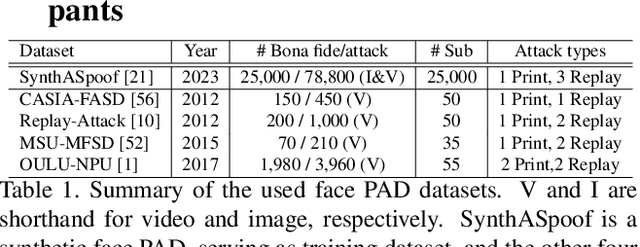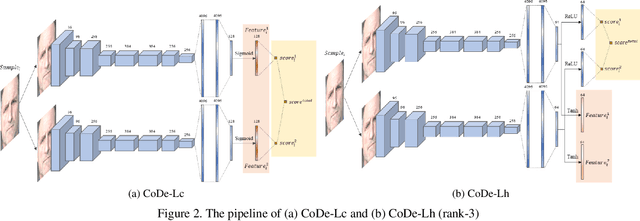Carlos Aravena
First Competition on Presentation Attack Detection on ID Card
Aug 31, 2024



Abstract:This paper summarises the Competition on Presentation Attack Detection on ID Cards (PAD-IDCard) held at the 2024 International Joint Conference on Biometrics (IJCB2024). The competition attracted a total of ten registered teams, both from academia and industry. In the end, the participating teams submitted five valid submissions, with eight models to be evaluated by the organisers. The competition presented an independent assessment of current state-of-the-art algorithms. Today, no independent evaluation on cross-dataset is available; therefore, this work determined the state-of-the-art on ID cards. To reach this goal, a sequestered test set and baseline algorithms were used to evaluate and compare all the proposals. The sequestered test dataset contains ID cards from four different countries. In summary, a team that chose to be "Anonymous" reached the best average ranking results of 74.80%, followed very closely by the "IDVC" team with 77.65%.
SynFacePAD 2023: Competition on Face Presentation Attack Detection Based on Privacy-aware Synthetic Training Data
Nov 09, 2023



Abstract:This paper presents a summary of the Competition on Face Presentation Attack Detection Based on Privacy-aware Synthetic Training Data (SynFacePAD 2023) held at the 2023 International Joint Conference on Biometrics (IJCB 2023). The competition attracted a total of 8 participating teams with valid submissions from academia and industry. The competition aimed to motivate and attract solutions that target detecting face presentation attacks while considering synthetic-based training data motivated by privacy, legal and ethical concerns associated with personal data. To achieve that, the training data used by the participants was limited to synthetic data provided by the organizers. The submitted solutions presented innovations and novel approaches that led to outperforming the considered baseline in the investigated benchmarks.
Iris Liveness Detection Competition (LivDet-Iris) -- The 2023 Edition
Oct 06, 2023



Abstract:This paper describes the results of the 2023 edition of the ''LivDet'' series of iris presentation attack detection (PAD) competitions. New elements in this fifth competition include (1) GAN-generated iris images as a category of presentation attack instruments (PAI), and (2) an evaluation of human accuracy at detecting PAI as a reference benchmark. Clarkson University and the University of Notre Dame contributed image datasets for the competition, composed of samples representing seven different PAI categories, as well as baseline PAD algorithms. Fraunhofer IGD, Beijing University of Civil Engineering and Architecture, and Hochschule Darmstadt contributed results for a total of eight PAD algorithms to the competition. Accuracy results are analyzed by different PAI types, and compared to human accuracy. Overall, the Fraunhofer IGD algorithm, using an attention-based pixel-wise binary supervision network, showed the best-weighted accuracy results (average classification error rate of 37.31%), while the Beijing University of Civil Engineering and Architecture's algorithm won when equal weights for each PAI were given (average classification rate of 22.15%). These results suggest that iris PAD is still a challenging problem.
Flickr-PAD: New Face High-Resolution Presentation Attack Detection Database
Apr 25, 2023Abstract:Nowadays, Presentation Attack Detection is a very active research area. Several databases are constituted in the state-of-the-art using images extracted from videos. One of the main problems identified is that many databases present a low-quality, small image size and do not represent an operational scenario in a real remote biometric system. Currently, these images are captured from smartphones with high-quality and bigger resolutions. In order to increase the diversity of image quality, this work presents a new PAD database based on open-access Flickr images called: "Flickr-PAD". Our new hand-made database shows high-quality printed and screen scenarios. This will help researchers to compare new approaches to existing algorithms on a wider database. This database will be available for other researchers. A leave-one-out protocol was used to train and evaluate three PAD models based on MobileNet-V3 (small and large) and EfficientNet-B0. The best result was reached with MobileNet-V3 large with BPCER10 of 7.08% and BPCER20 of 11.15%.
Impact of Face Image Quality Estimation on Presentation Attack Detection
Sep 30, 2022



Abstract:Non-referential face image quality assessment methods have gained popularity as a pre-filtering step on face recognition systems. In most of them, the quality score is usually designed with face matching in mind. However, a small amount of work has been done on measuring their impact and usefulness on Presentation Attack Detection (PAD). In this paper, we study the effect of quality assessment methods on filtering bona fide and attack samples, their impact on PAD systems, and how the performance of such systems is improved when training on a filtered (by quality) dataset. On a Vision Transformer PAD algorithm, a reduction of 20% of the training dataset by removing lower quality samples allowed us to improve the BPCER by 3% in a cross-dataset test.
 Add to Chrome
Add to Chrome Add to Firefox
Add to Firefox Add to Edge
Add to Edge